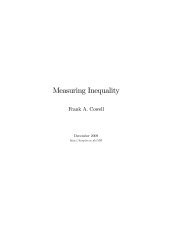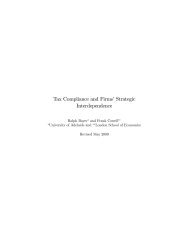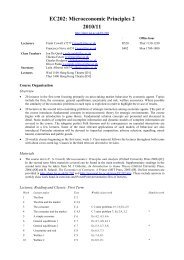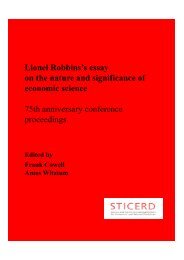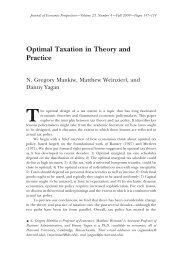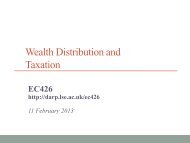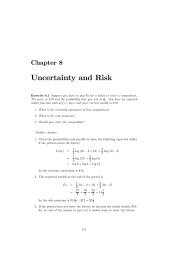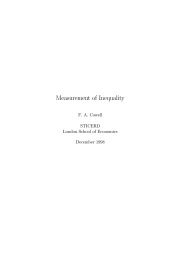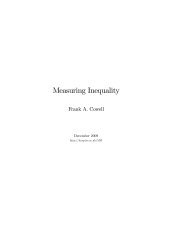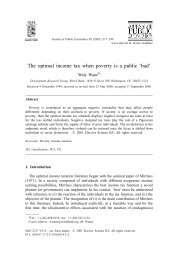Fertility and Female Labor Supply in Latin America - DARP
Fertility and Female Labor Supply in Latin America - DARP
Fertility and Female Labor Supply in Latin America - DARP
You also want an ePaper? Increase the reach of your titles
YUMPU automatically turns print PDFs into web optimized ePapers that Google loves.
ARTICLE IN PRESS+ modelLabour Economics xx (2005) xxx–xxxwww.elsevier.com/locate/econbase<strong>Fertility</strong> <strong>and</strong> female labor supply <strong>in</strong> Lat<strong>in</strong> <strong>America</strong>:New causal evidenceGuillermo Cruces a , Sebastian Galiani b, *a ECLAC (Santiago de Chile) <strong>and</strong> STICERD-London School of Economics,Houghton St., London WC2A 2AE, United K<strong>in</strong>gdomb Universidad de San Andrés, Vito Dumas 284, (B1644BID) Victoria, Prov<strong>in</strong>cia de Buenos Aires, Argent<strong>in</strong>aReceived 21 December 2004; received <strong>in</strong> revised form 9 October 2005; accepted 10 October 2005AbstractWe study the effect of fertility on maternal labor supply <strong>in</strong> Argent<strong>in</strong>a <strong>and</strong> Mexico exploit<strong>in</strong>g a source ofexogenous variability <strong>in</strong> family size first <strong>in</strong>troduced by Angrist <strong>and</strong> Evans [Angrist, J., Evans, W., 1998.Children <strong>and</strong> their parents’ labor supply: evidence from exogenous variation <strong>in</strong> family size. <strong>America</strong>nEconomic Review 88 (3), 450–577] for the United States. We f<strong>in</strong>d that the estimates for the US can begeneralized both qualitatively <strong>and</strong> quantitatively to the populations of two develop<strong>in</strong>g countries where,compared to the US, fertility is known to be higher, female education levels are much lower <strong>and</strong> there arefewer formal facilities for childcare.D 2005 Elsevier B.V. All rights reserved.JEL classification: J13; J22Keywords: Causality; Childbear<strong>in</strong>g <strong>and</strong> female labor supply <strong>in</strong> develop<strong>in</strong>g countries1. IntroductionA significant change <strong>in</strong> human behavior dur<strong>in</strong>g the past century was the massive<strong>in</strong>corporation of women <strong>in</strong>to the labor force. Not surpris<strong>in</strong>gly, there is an extensivetheoretical <strong>and</strong> empirical literature attempt<strong>in</strong>g to expla<strong>in</strong> female labor supply <strong>and</strong> itsevolution. In particular, the relationship between fertility <strong>and</strong> female labor supply is oflongst<strong>and</strong><strong>in</strong>g <strong>in</strong>terest <strong>in</strong> the social sciences. Much of the research effort has been devoted todisentangl<strong>in</strong>g the causal mechanisms l<strong>in</strong>k<strong>in</strong>g childbear<strong>in</strong>g <strong>and</strong> female labor supply. Recently,* Correspond<strong>in</strong>g author. Tel.: +54 11 4725 7053.E-mail addresses: g.a.cruces@lse.ac.uk (G. Cruces), sgaliani@udesa.edu.ar (S. Galiani).0927-5371/$ - see front matter D 2005 Elsevier B.V. All rights reserved.doi:10.1016/j.labeco.2005.10.006LABECO-00719; No of Pages 9
ARTICLE IN PRESS2G. Cruces, S. Galiani / Labour Economics xx (2005) xxx–xxxAngrist <strong>and</strong> Evans (1998) (henceforth AE) have made substantial progress <strong>in</strong> this area.Their identification strategy exploits parental preferences for a mixed sibl<strong>in</strong>g sexcomposition as an <strong>in</strong>strument for fertility. S<strong>in</strong>ce parents of same-sex sibl<strong>in</strong>gs are significantlymore likely to have an additional child, <strong>and</strong> the sex mix is virtually r<strong>and</strong>omlyassigned, an <strong>in</strong>dicator variable for whether the sex of the second child matches the sex ofthe first child provides a plausible <strong>in</strong>strument for further childbear<strong>in</strong>g among women with atleast two children.In this paper, we exploit AE’s identification strategy to estimate the causal effect ofchildbear<strong>in</strong>g on maternal labor supply <strong>in</strong> two middle-<strong>in</strong>come Lat<strong>in</strong> <strong>America</strong>n countries:Argent<strong>in</strong>a <strong>and</strong> Mexico. Thus, we <strong>in</strong>vestigate the extent to which the causal l<strong>in</strong>k identified <strong>in</strong>AE can be generalized to the context of develop<strong>in</strong>g countries where, compared to the US,fertility is known to be higher, female education levels are much lower <strong>and</strong> there are fewerformal facilities for childcare. This is of <strong>in</strong>terest <strong>in</strong> of itself but also because, ultimately, theexternal validity of all causal estimates is established by replication <strong>in</strong> other datasets(Angrist, 2004).The rest of the paper is organized as follows. In the next section we describe the data<strong>and</strong> provide a set of summary statistics. We then present <strong>and</strong> discuss the estimation strategy.This is followed by the ma<strong>in</strong> results of the paper. Conclusions follow.2. Data <strong>and</strong> summary statisticsOur datasets are gathered from the extended questionnaire samples of both the Mexico 2000<strong>and</strong> the Argent<strong>in</strong>a 1991 censuses, conducted respectively by the National Institute of Statistics,Geography <strong>and</strong> Comput<strong>in</strong>g (Instituto Nacional de Estadística, Geografía e Informática,INEGI) <strong>and</strong> the National Institute of Statistics <strong>and</strong> Censuses (Instituto Nacional de Estadísticasy Censos, INDEC). The two result <strong>in</strong> large <strong>and</strong> nationally representative datasets. ForArgent<strong>in</strong>a, we have data on 16,023,180 <strong>in</strong>dividuals <strong>and</strong> 4,287,580 households, cover<strong>in</strong>g around50 percent of the whole population. For Mexico the sample consists of 10,099,182 <strong>in</strong>dividuals<strong>and</strong> 2,312,034 households, cover<strong>in</strong>g around 10 percent of the total population. We restrict oursample to women between 21 <strong>and</strong> 35 years old, with at least two children, <strong>and</strong> whose oldestchild was at most 18 years old at the time of the census. Follow<strong>in</strong>g AE, we also exclude fromthe analysis women whose second child is younger than a year old, <strong>and</strong> carry out our analysisseparately on all women <strong>and</strong> married women. Thus, our f<strong>in</strong>al samples sizes are 599,941 (total)<strong>and</strong> 456,437 (married) observations for Argent<strong>in</strong>a, <strong>and</strong> 458,849 (total) <strong>and</strong> 355,730 (married)for Mexico.Table 1 presents descriptive statistics <strong>and</strong> variable def<strong>in</strong>itions. <strong>Female</strong> employment for ourmarried samples are much higher (30.5 percent) <strong>in</strong> Argent<strong>in</strong>a than <strong>in</strong> Mexico (22 percent), butthey are both significantly lower than the US figures for equivalent samples (52.8 percent <strong>in</strong>1980 <strong>and</strong> 66.7 <strong>in</strong> 1990). Both <strong>in</strong> Argent<strong>in</strong>a <strong>and</strong> Mexico, female labor supply is lower for marriedwomen than for unmarried women. With respect to fertility, the average number of children ishigher for married women <strong>in</strong> Mexico (3.035) than <strong>in</strong> Argent<strong>in</strong>a (2.985), <strong>and</strong> higher than therespective US figure (around 2.5 <strong>in</strong> both the 1980 <strong>and</strong> 1990 censuses).In this paper, the fertility variable of <strong>in</strong>terest– i.e., the caus<strong>in</strong>g variable <strong>in</strong> our empirical laborsupply regression models– is the <strong>in</strong>dicator More than two children, which is <strong>in</strong>strumented bythe <strong>in</strong>dicators: Same sex, Two boys <strong>and</strong> Two girls. In both Argent<strong>in</strong>a <strong>and</strong> Mexico, slightlyabove 50 percent of the women <strong>in</strong> any of the samples considered have a third child while <strong>in</strong> theUS the same figure is only about 36 to 40 percent. We also report <strong>in</strong>dicators for whether the
ARTICLE IN PRESSG. Cruces, S. Galiani / Labour Economics xx (2005) xxx–xxx 3Table 1Summary statisticsfirst <strong>and</strong> second children were boys. F<strong>in</strong>ally, Table 1 also presents the women’s age <strong>and</strong> age atfirst birth.3. Estimation strategy3.1. Empirical modelArgent<strong>in</strong>a 1991 Mexico 2000All women MarriedAll womenwomenMarriedwomenWorked for pay0.315 (0.465) 0.305 (0.460) 0.239 (0.426) 0.220 (0.414)(=1 if workedfor pay, 0 otherwise)More than 2 children0.596 (0.491) 0.574 (0.495) 0.592 (0.491) 0.593 (0.491)(=1 if mother hadmore than twochildren, 0 otherwise)Number of children 3.062 (1.240) 2.985 (1.183) 3.029 (1.188) 3.035 (1.197)Same Sex (=1 if first0.506 (0.500) 0.505 (0.500) 0.503 (0.500) 0.503 (0.500)two childrenwere the same sex,0 otherwise)Two boys (=1 if two0.260 (0.438) 0.261 (0.439) 0.261 (0.439) 0.261 (0.439)children were boys,0 otherwise)Two Girls (=1 if two0.246 (0.431) 0.244 (0.430) 0.243 (0.429) 0.242 (0.428)children were girls,0 otherwise)Boy 1st (=1 if first child 0.508 (0.500) 0.510 (0.500) 0.512 (0.500) 0.512 (0.500)was a boy, 0 otherwise)Boy 2nd (=1 if second0.506 (0.500) 0.507 (0.500) 0.507 (0.500) 0.507 (0.500)child wasa boy, 0 otherwise)Age 29.660 (3.770) 29.928 (3.652) 29.440 (3.758) 29.651 (3.683)Age at first birth 20.641 (3.337) 20.932 (3.340) 19.930 (3.083) 20.095 (3.101)Observations 599,941 456,437 458,849 355,730Means <strong>and</strong> st<strong>and</strong>ard deviations (<strong>in</strong> parentheses). The samples correspond to the extended questionnaire sample of the1991 Census, Argent<strong>in</strong>a <strong>and</strong> the 2000 Census, Mexico. Samples as described <strong>in</strong> the data appendix.Let D i be an <strong>in</strong>dicator for women with more than two children <strong>in</strong> a sample of women with atleast two children. Additionally, let Y 1i be the labor supply of mother i if D i equals 1 <strong>and</strong> Y 0idenote her labor supply otherwise; let X be a vector of control variables; <strong>and</strong> let Z i be an<strong>in</strong>dicator equal to one if a woman’s first two children were of the same sex, <strong>and</strong> equal to zerootherwise. We estimate the follow<strong>in</strong>g l<strong>in</strong>ear model:Y i ¼ X i Vb þ aD i þ e i :ð1ÞIn Section 4, we present Two-Stages Least Squares (2SLS) estimates of the parameter of<strong>in</strong>terest from model (1), where we saturate the whole set of control variables. 1 We then also1 However, s<strong>in</strong>ce the potential outcome conditional expectation function (CEF) is also a function of the caus<strong>in</strong>gvariable, we denote this empirical model as an balmost saturatedQ model.
ARTICLE IN PRESS4G. Cruces, S. Galiani / Labour Economics xx (2005) xxx–xxxreport estimates from the IV estimator developed by Abadie (2003), which allows a flexiblenonl<strong>in</strong>ear approximation of the causal response function. 23.2. First stagesThe evidence presented <strong>in</strong> the top panel of Table 2 confirms the presence of an effect of sexpreferences <strong>in</strong> further childbear<strong>in</strong>g for women with at least two children <strong>in</strong> Argent<strong>in</strong>a <strong>and</strong>Mexico. This panel presents the coefficients of Same Sex (first row) <strong>and</strong> Two boys <strong>and</strong> Two girls<strong>in</strong> two separate regressions (second <strong>and</strong> third rows) with More than two children as thedependent variable, with a set of demographic controls as described <strong>in</strong> the Table.In both countries, women who have had two children of the same sex have a higherprobability of hav<strong>in</strong>g a third child (<strong>and</strong>, naturally, also a higher number of children) than womenwho have had two children of different sex (Mixed sex). The difference <strong>in</strong> these conditionalprobabilities are around 3.6–4.1 percentage po<strong>in</strong>ts <strong>in</strong> Argent<strong>in</strong>a (all-married) <strong>and</strong> 3.3–3.7percentage po<strong>in</strong>ts <strong>in</strong> Mexico (all-married). These differences, significant at the 1 percent level,are close to those found by AE for the US, <strong>and</strong> represent evidence of a sex mix preferencephenomenon <strong>in</strong> both Argent<strong>in</strong>a <strong>and</strong> Mexico.Table 2 also shows that women who have two girls have on average a 4.7–5.3 (all-married,Argent<strong>in</strong>a) <strong>and</strong> 4.3–4.6 (all-married, Mexico) percentage po<strong>in</strong>t higher probability of hav<strong>in</strong>g athird child, while these figures are lower for women who have had two boys (around 2.6–3 <strong>and</strong>2.5–2.8 percentage po<strong>in</strong>ts, respectively). Nevertheless, the significance of both variables<strong>in</strong>dicates the presence of mixed sex sibl<strong>in</strong>g preference <strong>in</strong> both countries, with an additional biasfor boys. 3 AE report similar results on a difference <strong>in</strong> the probability of further childbear<strong>in</strong>gbetween women who have had two boys, <strong>and</strong> women who have had two girls, for the 1980(though not <strong>in</strong> the 1990) data for the United States.3.3. Exclusion restrictionGiven the presence of mixed sex sibl<strong>in</strong>g preferences comb<strong>in</strong>ed with a relatively higherpreference for boys, we now discuss the potential implications of this phenomenon on thevalidity of us<strong>in</strong>g the Same sex variable (or Two boys <strong>and</strong> Two girls) as an <strong>in</strong>strument for Morethan two children <strong>in</strong> the context of Argent<strong>in</strong>a <strong>and</strong> Mexico.S<strong>in</strong>ce exclusion restrictions are non-testable directly, their plausibility must be evaluated on acase-by-case basis. In some develop<strong>in</strong>g countries, there might be concerns that the presence ofstrong son preferences could affect the sex composition of children, either through stopp<strong>in</strong>g rulesor selective abortion, violat<strong>in</strong>g the exclusion restriction. However, the evidence for our samplerules out this concern: both <strong>in</strong> Argent<strong>in</strong>a <strong>and</strong> Mexico, the <strong>in</strong>fant sex ratios (the ratio of boys togirls aged zero to four) are approximately equal to the biological ones, which are about 1.04. Onthe contrary, for <strong>in</strong>stance, <strong>in</strong> Ch<strong>in</strong>a <strong>and</strong> Korea, the <strong>in</strong>fant sex ratios show evidence of parentalactions affect<strong>in</strong>g biological sex ratios (see, among others, Basu <strong>and</strong> Das Gupta, 2001).Basu <strong>and</strong> Das Gupta (2001) also argue that beyond cultural <strong>and</strong> religious factors, somesocieties exhibit a strong son preference because of the gap between sons’ <strong>and</strong> daughters’2 Abadie’s (2003) bCausal IVQ estimates have a robust causal <strong>in</strong>terpretation regardless of the shape of the actual CEF forpotential outcomes, s<strong>in</strong>ce identification is atta<strong>in</strong>ed non-parametrically.3 Strict son preference with no mixed sex sibl<strong>in</strong>g preference requires a coefficient of Two boys not significantlydifferent from zero (Leung, 1991).
ARTICLE IN PRESSG. Cruces, S. Galiani / Labour Economics xx (2005) xxx–xxx 5Table 2First <strong>and</strong> second stages, almost saturated modelArgent<strong>in</strong>aMexicoAll women All women Married womenFirst stage-dependent variable: More than two childrenCoefficient of:Same Sex a 0.0366*** [0.0012] 0.0413*** [0.0014] 0.0336*** [0.0013] 0.0371*** [0.0015]Two Boys b 0.0260*** [0.0017] 0.0300*** [0.0019] 0.0247*** [0.0019] 0.0284*** [0.0021]Two Girls b 0.0475*** [0.0017] 0.0529*** [0.0019] 0.0429*** [0.0019] 0.0461*** [0.0021]Second stage-<strong>in</strong>strumented variable: More than two childrenOLS a 0.0969*** [0.0013] 0.0828*** [0.0015] 0.0903*** [0.0014] 0.0812*** [0.0015]IV: Same Sex a 0.0817** [0.0323] 0.0958*** [0.0325] 0.0631* [0.0370] 0.0862** [0.0370]Split Sample IV: 0.1020** [0.0435] 0.1645*** [0.0472] 0.0911* [0.0521] 0.1126** [0.0561]Same Sex aIV: Same0.0814*** [0.0333] 0.0953*** [0.0378] 0.0631* [0.03962] 0.0862** [0.0415]Sex a -Abadie’sestimatorIV: Two Boys 0.0652** [0.0310] 0.0821*** [0.0313] 0.0445 [0.0357] 0.0721** [0.0360]<strong>and</strong> Two Girls bSargan p-value 0.0701 0.1121 0.0545 0.1015Observations 599,941 456,437 458,849 355,730St<strong>and</strong>ard errors <strong>in</strong> brackets. * significant at 10%; ** significant at 5%; *** significant at 1%. All regressions <strong>in</strong>clude ma<strong>in</strong>effects <strong>and</strong> <strong>in</strong>teractions for five categories of age, five categories of age at first birth, <strong>and</strong> sex of the first children (49<strong>in</strong>dicator variables <strong>in</strong> total). St<strong>and</strong>ard errors for Abadie’s estimator (expla<strong>in</strong>ed <strong>in</strong> footnote 10 <strong>in</strong> the text) were obta<strong>in</strong>ed by500 bootstrap replications. The implementation of the SSIV estimator is discussed <strong>in</strong> footnote 8 <strong>in</strong> the text. Samples asdescribed <strong>in</strong> the text <strong>and</strong> the data appendix.a Control for sex of first <strong>and</strong> second children.b Control for sex of first child.bability to contribute to the physical, emotional <strong>and</strong> f<strong>in</strong>ancial well-be<strong>in</strong>g of their parentalhousehold.Q Family <strong>in</strong>stitutions both <strong>in</strong> Argent<strong>in</strong>a <strong>and</strong> Mexico, however, do not exhibit anysevere form of son preference. Dowries are virtually unheard of <strong>in</strong> both countries, <strong>and</strong> extremepreferences for sons imply forms of discrim<strong>in</strong>ation aga<strong>in</strong>st girls that are not observed <strong>in</strong> Lat<strong>in</strong><strong>America</strong> <strong>in</strong> general. The <strong>in</strong>fant sex ratios also represent evidence of the lack of a systematiceffect of son preference on the mortality of girls. Moreover, additional evidence shows that both<strong>in</strong> Argent<strong>in</strong>a <strong>and</strong> Mexico the primary school enrollment rates are virtually the same for boys <strong>and</strong>girls, <strong>and</strong> <strong>in</strong> Argent<strong>in</strong>a girls actually have higher enrollment <strong>and</strong> completion rates <strong>in</strong> secondary<strong>and</strong> tertiary education (Pantelides, 2002).F<strong>in</strong>ally, another possible threat to the validity of the identification strategy is posed byRosenzweig <strong>and</strong> Wolp<strong>in</strong> (2000). Study<strong>in</strong>g outlays per children <strong>in</strong> rural India, they f<strong>in</strong>d thatsame sex sibl<strong>in</strong>gs are related to substantially lower levels of expenditure. They attribute thiseffect to bh<strong>and</strong>-me-downQ sav<strong>in</strong>gs, which are more likely to arise when there are children of thesame sex <strong>in</strong> the household for items such as cloth<strong>in</strong>g <strong>and</strong> footwear. S<strong>in</strong>ce these items representa sizeable fraction of the household’s expenditures, they note that the sex composition ofchildren plausibly alters labor supply through mechanisms other than through fertility changealone.While expenditure data per child is not available for Argent<strong>in</strong>a or Mexico, survey datasuggests that sex composition is unlikely to have a noticeable effect on expenditure.Rosenzweig <strong>and</strong> Wolp<strong>in</strong> (2000) f<strong>in</strong>d <strong>in</strong> their Indian data that cloth<strong>in</strong>g expenditures on children
ARTICLE IN PRESS6G. Cruces, S. Galiani / Labour Economics xx (2005) xxx–xxxunder 18 represents 11 percent of household <strong>in</strong>come. For Mexico, Hernández Franco <strong>and</strong> PérezGarcía (2003) report that <strong>in</strong> the year 2000 households spent around 4.8 percent of their budgeton cloth<strong>in</strong>g <strong>and</strong> footwear for all members of the family, with little variation among deciles ofhousehold <strong>in</strong>come. Meanwhile, Argent<strong>in</strong>e households <strong>in</strong> 1987 devoted 6.7 percent of theirbudget to the same items (for all members), <strong>and</strong> only 2.8 percent on cloth<strong>in</strong>g <strong>and</strong> foot wear forchildren aged 10 or less. 4 Rosenzweig <strong>and</strong> Wolp<strong>in</strong>’s (2000) estimated bh<strong>and</strong>-me-downQ sav<strong>in</strong>gsfor these goods amounts to 1.3 percent of average earn<strong>in</strong>gs: even assum<strong>in</strong>g that these sav<strong>in</strong>gsexist <strong>in</strong> Argent<strong>in</strong>a <strong>and</strong> Mexico (<strong>and</strong> that they have a direct effect on labor supply), their sizewould be too small to account for a mean<strong>in</strong>gful reduced form relationship between a same sex<strong>in</strong>dicator <strong>and</strong> parental labor supply.Thus, the evidence presented <strong>in</strong> this section suggests that the bias for boys observed <strong>in</strong> oursamples is likely to be ma<strong>in</strong>ly the result of cultural preferences. There is no evidence of strongdiscrim<strong>in</strong>ation aga<strong>in</strong>st girls <strong>in</strong> Argent<strong>in</strong>a or <strong>in</strong> Mexico, <strong>and</strong> it is unlikely that the sex compositionof children affects significantly the consumption pattern of households <strong>in</strong> any of the twocountries. Thus, the comb<strong>in</strong>ed preferences for a mixed sex sibl<strong>in</strong>g composition with a bias forboys may reflect ma<strong>in</strong>ly cultural factors. If these are the ma<strong>in</strong> reasons beh<strong>in</strong>d the bias for boys,there should not be a major concern about the exogeneity of the Same sex <strong>in</strong>dicator as an<strong>in</strong>strument for fertility.4. Ma<strong>in</strong> resultsThe bottom panel of Table 2 presents the estimation of model (1) by OLS <strong>and</strong> aseries of IV models. We <strong>in</strong>clude a set of st<strong>and</strong>ard control variables: age of the woman,her age at first birth, sex of the first child <strong>and</strong> sex of the second child (see Angrist <strong>and</strong>Evans, 1998). In order to saturate the model, we map both age <strong>and</strong> age at first birth<strong>in</strong>to five categories each, <strong>and</strong> then create a set of forty-n<strong>in</strong>e mutually exclusively<strong>in</strong>dicators by <strong>in</strong>teract<strong>in</strong>g them with the aforementioned control variables. 5, 6 Condition<strong>in</strong>gon the sex of the first two children allows us to control for any secular additive effect of childgender on female participation. This is useful because Same sex is potentially correlated with thesex of either child, which is of concern if this affects labor supply for reasons other than familysize.The first row presents the simple OLS estimates, which <strong>in</strong>dicate a strongly significantnegative correlation between hav<strong>in</strong>g more than two children <strong>and</strong> female labor supply. TheIV results, presented <strong>in</strong> the follow<strong>in</strong>g row, imply for Argent<strong>in</strong>a that hav<strong>in</strong>g more than twochildren reduces a mother’s labor supply by about 8.1–9.6 percentage po<strong>in</strong>ts (all-married–significant at the 5 <strong>and</strong> 1 percent levels, respectively), with a similar effect observed forMexico: 6.3–8.6 percentage po<strong>in</strong>ts (all-married, significant at the 10 <strong>and</strong> 5% levels). Theseresults are quite close to the 1990 US estimates reported by AE (8.4 percentage po<strong>in</strong>ts),4 The figures for Argent<strong>in</strong>a are based on the 1996/7 Expenditure Survey by INDEC. Based on further evidence fromthis survey (available upon request), we failed to f<strong>in</strong>d any effect of the sex composition of children on the budget sharesof cloth<strong>in</strong>g, education, food <strong>and</strong> other categories of goods.5 The five age category <strong>in</strong>dicators were chosen to conta<strong>in</strong> approximately the same number of observations <strong>in</strong> each ofthem, <strong>and</strong> were def<strong>in</strong>ed as 21–25, 26–28, 29–30, 31–32 <strong>and</strong> 33–35 for age, <strong>and</strong> 17 or less, 18–19, 20–21, 22–23 <strong>and</strong> 24<strong>and</strong> more for age at first birth.6 We also fitted a more parsimonious version of these models <strong>in</strong>clud<strong>in</strong>g controls for the cont<strong>in</strong>uous variables Age <strong>and</strong>Age at first birth, <strong>and</strong> <strong>in</strong>dicators for the sex of the first <strong>and</strong> second child, <strong>in</strong>stead of <strong>in</strong>teractions of categorized versions ofthese variables. The results were almost identical, <strong>and</strong> are available upon request.
ARTICLE IN PRESSG. Cruces, S. Galiani / Labour Economics xx (2005) xxx–xxx 7although they are lower than the US 1980 effects (10.4 percentage po<strong>in</strong>ts). 7 F<strong>in</strong>ally, it shouldbe noted that there is no systematic pattern of differences between IV <strong>and</strong> OLS estimates of thesame coefficients.In order to explore whether IV estimates are biased toward OLS, <strong>in</strong> the second row of thesecond panel <strong>in</strong> Table 2 we report the results obta<strong>in</strong>ed by split sample IV (SSIV) estimation,which are biased towards zero <strong>and</strong> not towards OLS (see Angrist <strong>and</strong> Krueger, 1995). 8 Theestimates obta<strong>in</strong>ed by SSIV are all significantly different from zero, <strong>and</strong> they are even higher (<strong>in</strong>absolute value) than the IV results for both Argent<strong>in</strong>a <strong>and</strong> Mexico. Thus, we do not f<strong>in</strong>devidence suggest<strong>in</strong>g that our IV estimates are biased toward OLS. It is worth remember<strong>in</strong>g that,<strong>in</strong> general, the Same sex IV strategy identifies the average effect of hav<strong>in</strong>g more than twochildren on those whose fertility decisions are changed by the <strong>in</strong>strument (compliers), whileOLS is suspected to fail at identify<strong>in</strong>g the same effect averaged over the whole population (seeAngrist et al., 1996). Thus, with this <strong>in</strong>terpretation <strong>in</strong> m<strong>in</strong>d, the f<strong>in</strong>d<strong>in</strong>g that IV <strong>and</strong> OLSestimates are similar is not worrisome. 9The follow<strong>in</strong>g row <strong>in</strong> Table 2 presents Abadie’s (2003) IV estimates. 10 The results are almostidentical to the 2SLS just described, show<strong>in</strong>g that our almost saturated model captures extremelywell the CEF of female labor supply.In addition, the Same sex <strong>in</strong>dicator is easily decomposed <strong>in</strong>to two variables <strong>in</strong>dicat<strong>in</strong>g the sexcomposition of the first two children, Two boys <strong>and</strong> Two girls, lead<strong>in</strong>g to an overidentifiedmodel. AE show that this is useful because the bias from any secular effects of child gender onlabor supply should be different from these two <strong>in</strong>struments, while the labor supplyconsequences of childbear<strong>in</strong>g seem likely to be <strong>in</strong>dependent of whether Same sex equals Twoboys or Two girls. Thus, an appropriate specification test is the Sargan test or test ofoveridentify<strong>in</strong>g restrictions. However, when More than two children is <strong>in</strong>strumented by bothTwo boys <strong>and</strong> Two girls, it is not possible to control for the effects for the sex of each child, <strong>and</strong>so we report results that control only for the sex of the first child (as <strong>in</strong> AE).The Generalized Instrumental Variables Estimates (GIVE) are smaller (<strong>in</strong> absolute terms) thanthe IV <strong>and</strong> OLS ones. However, the differences are never statistically significant at conventionallevels of significance. F<strong>in</strong>ally, the statistics of contrast of a st<strong>and</strong>ard Sargan test of overidentify<strong>in</strong>grestrictions reject the null hypothesis at or near the 10 percent level for any of thefour samples considered. A caveat is <strong>in</strong> order here: while higher than 5 percent <strong>in</strong> all cases, the P-7 These results are also robust to: a) us<strong>in</strong>g labor force participation as the dependent variable <strong>in</strong>stead the alternativeWorked for pay; b) us<strong>in</strong>g different age groups to draw our sample of women: all estimates are very similar if we use<strong>in</strong>stead women aged 18–35 or 21–45; c) <strong>in</strong>clud<strong>in</strong>g <strong>in</strong> the sample women whose second child is younger than a year old;<strong>and</strong> d) <strong>in</strong>clud<strong>in</strong>g <strong>in</strong> the sample some women that were discarded because of mismatches (see data appendix). We alsoadded municipality dummy variables <strong>and</strong>, aga<strong>in</strong>, the estimates do not change at all. F<strong>in</strong>ally, the results were unalteredwhen we <strong>in</strong>cluded the spouse controls <strong>in</strong>stead of the women’s. All of these results are available upon request.8 We obta<strong>in</strong>ed these results by splitt<strong>in</strong>g the samples r<strong>and</strong>omly <strong>in</strong> two halves, comput<strong>in</strong>g the first stage regression withthe first half sample <strong>and</strong> us<strong>in</strong>g the coefficients of this regression to predict the values of the <strong>in</strong>strumented variable <strong>in</strong> thesecond half sample. These predicted values were then used <strong>in</strong> the second stage regression <strong>in</strong> the second half sample,computed by OLS. The st<strong>and</strong>ard errors of the estimate were adjusted to take <strong>in</strong>to account the fact that the <strong>in</strong>strumentedvariable was estimated.9 See Card (2000) for a similar argument <strong>in</strong> reconcil<strong>in</strong>g IV <strong>and</strong> OLS estimates of the effect of school<strong>in</strong>g on earn<strong>in</strong>gs.10 We implement a simple two-step version of Abadie’s (2003) estimator based on a l<strong>in</strong>ear specification of the LocalAverage Response Function. In the first step, we estimate by OLS the model Z i =X I ’g+ e i . The predicted values from thisregression are then used to construct the estimated weights Ki (Abadie, 2003, Theorem 3.1). We f<strong>in</strong>ally use these weightsto estimate the model given by Eq. (1), Y i =X I ’h+ aD i + i , by weighted least squares (Abadie, 2003, Eq. (14)). Thest<strong>and</strong>ard errors of the estimator were obta<strong>in</strong>ed by 500 bootstrap replications of this procedure.
ARTICLE IN PRESS8G. Cruces, S. Galiani / Labour Economics xx (2005) xxx–xxxValues for these tests are still low <strong>and</strong> may be highlight<strong>in</strong>g the limits of the validity of theexclusion restrictions <strong>in</strong> our samples. 11All <strong>in</strong> all, the evidence presented <strong>in</strong> this paper reveals that the effect of fertility on female laborsupply, identified by apply<strong>in</strong>g the AE strategy, is qualitatively similar <strong>in</strong> Argent<strong>in</strong>a, Mexico <strong>and</strong> theUnited States. The next question is whether the effects are of the same order of magnitude orwhether they differ substantially. A test of the hypotheses that the effect of fertility on femaleemployment for Argent<strong>in</strong>a (1991), Mexico (2000) <strong>and</strong> the United States (1990, from AE) does notreject the null at st<strong>and</strong>ard levels of statistical significance. Thus, we can assert that <strong>in</strong> the US, <strong>and</strong> <strong>in</strong>Argent<strong>in</strong>a <strong>and</strong> Mexico, the average effect of go<strong>in</strong>g from a family size of two children to more thantwo is statistically similar (for those whose treatment status is changed by the Same sex <strong>in</strong>strument).5. ConclusionWe study the effect of women’s fertility on labor supply <strong>in</strong> Argent<strong>in</strong>a <strong>and</strong> Mexico exploit<strong>in</strong>gan <strong>in</strong>strumental variable estimator first <strong>in</strong>troduced by Angrist <strong>and</strong> Evans (1998) for the UnitedStates. Our study shows that the bmixed sex sibl<strong>in</strong>g preferenceQ, the basis of AE identificationstrategy, is present <strong>in</strong> Argent<strong>in</strong>a <strong>and</strong> Mexico. More importantly, we f<strong>in</strong>d that the AE estimates forthe US can be generalized both qualitatively <strong>and</strong> quantitatively to the populations of twodevelop<strong>in</strong>g countries that are different from the orig<strong>in</strong>al application.Appendix A. Data sourcesThe Argent<strong>in</strong>e dataset conta<strong>in</strong>s <strong>in</strong>formation on 16,023,180 <strong>in</strong>dividuals <strong>and</strong> 4,287,580households, from a total population of 32,245,467 <strong>in</strong>dividuals <strong>and</strong> 8,927,289 households. Weconstructed this dataset from the orig<strong>in</strong>al data tapes. The Mexican dataset covers 10.6 percent ofthe total population of 97,483,412 persons <strong>and</strong> 22,268,916 households, yield<strong>in</strong>g a sample size of10,099,182 <strong>in</strong>dividual records <strong>and</strong> 2,312,034 household records. The Mexican data is taken fromSobek et al. (2002).A.1. Match<strong>in</strong>g women <strong>and</strong> their childrenFor both Argent<strong>in</strong>a <strong>and</strong> Mexico, the relationship variable l<strong>in</strong>k<strong>in</strong>g members of a household<strong>in</strong>dicates k<strong>in</strong>ship with respect to the head of the household only. In order to match women withtheir own children, we restra<strong>in</strong> the sample to females who are heads or spouses of the heads ofhouseholds. In order to avoid assign<strong>in</strong>g all children of a male head to his current partner, whomight not be the mother of all children <strong>in</strong> the household, we first check that the reported numberof children alive (as asked for <strong>in</strong> a specific census question for both countries) co<strong>in</strong>cides with thenumber of children <strong>in</strong> the household matched to the woman, restra<strong>in</strong><strong>in</strong>g our samples to womenfor whom both numbers co<strong>in</strong>cide. F<strong>in</strong>ally, we made some extra adjustments based on the age ofthe woman <strong>and</strong>/or her husb<strong>and</strong>. We discard a small number of observations for which the age ofthe mother at first birth was less than 14, tak<strong>in</strong>g this as an <strong>in</strong>dicator of data entry errors or11 This is especially the case s<strong>in</strong>ce these tests are not very powerful <strong>in</strong> f<strong>in</strong>ite samples. In order to rule out the possibilitythat we do not reject the null because of lack of statistical power, we ran the same regressions with More than twochildren <strong>in</strong>strumented by Same sex, but <strong>in</strong>clud<strong>in</strong>g also b<strong>in</strong>validQ <strong>in</strong>struments: <strong>in</strong> Mexico, total household <strong>in</strong>come, <strong>and</strong> <strong>in</strong>Argent<strong>in</strong>a (s<strong>in</strong>ce this variable is not available) a proxy <strong>in</strong> the form of the woman’s education level, or the spouse’s levelfor married women. In all cases, we reject the null hypothesis of the validity of the over<strong>in</strong>dentify<strong>in</strong>g restriction at the 1percent level of statistical significance (the P-values are <strong>in</strong>dist<strong>in</strong>guishable from zero).
ARTICLE IN PRESSG. Cruces, S. Galiani / Labour Economics xx (2005) xxx–xxx 9misallocated children, s<strong>in</strong>ce most of the ages were far too low. We also dropped from our f<strong>in</strong>alsamples a very small fraction of married women for whom the husb<strong>and</strong>’s age at first birth wasless than 14.A.2. Worked for pay <strong>in</strong>dicatorIn the Argent<strong>in</strong>e census, an <strong>in</strong>dividual is classified as work<strong>in</strong>g for pay (Worked for pay<strong>in</strong>dicator equal to 1) if he or she works <strong>and</strong> is not a family worker without remuneration. Thus<strong>in</strong>dividuals work<strong>in</strong>g for pay <strong>in</strong>clude employees (wage earners), the self-employed, ownermanagers<strong>and</strong> civil <strong>and</strong> domestic servants. In Mexico, we use the same def<strong>in</strong>ition <strong>and</strong> classify an<strong>in</strong>dividual as work<strong>in</strong>g for pay if he or she does remunerated work.ReferencesAbadie, A., 2003. Semiparametric <strong>in</strong>strumental variable estimation of treatment response models. Journal ofEconometrics 113, 231–263.Angrist, J., 2004. Treatment effect heterogeneity <strong>in</strong> theory <strong>and</strong> practice. The Economic Journal 114 (494), C52–C83.Angrist, J., Evans, W., 1998. Children <strong>and</strong> their parents’ labor supply: evidence from exogenous variation <strong>in</strong> family size.<strong>America</strong>n Economic Review 88 (3), 450–577.Angrist, J., Krueger, A.B., 1995. Split sample <strong>in</strong>strumental variables estimates of the return to school<strong>in</strong>g. Journal ofBus<strong>in</strong>ess <strong>and</strong> Economic Statistics 13, 225–235.Angrist, J., Imbens, G., Rub<strong>in</strong>, D., 1996. Identification of causal effects us<strong>in</strong>g <strong>in</strong>strumental variables. Journal of the<strong>America</strong>n Statistical Association 91, 444–455.Basu, A., Das Gupta, M., 2001. Family systems <strong>and</strong> the preferred sex of children. In: Hoem, J. (Ed.), InternationalEncyclopedia of Social <strong>and</strong> Behavioral Sciences. Elsevier.Card, D., 2000. The causal effect of education on earn<strong>in</strong>gs. In: Ashenfelter, Orley, Card, David (Eds.), H<strong>and</strong>book of<strong>Labor</strong> Economics, vol. 3A. North-Holl<strong>and</strong>, Amsterdam.Hernández Franco, D., Pérez García, M., 2003. En el año 2000. Gasto de los hogares y pobreza en México, Cuadernos deDesarrollo Humano, No. 5, Secretaría de Desarrollo Social, México.Leung, S.F., 1991. A stochastic dynamic analysis of parental sex preferences <strong>and</strong> fertility. Quarterly Journal ofEconomics 106 (4), 1063–1088.Pantelides, E., 2002. Complet<strong>in</strong>g the fertility transition: the case of Argent<strong>in</strong>a, <strong>in</strong> United Nations, 2002. Complet<strong>in</strong>g thefertility transition, Report of the Expert Group Meet<strong>in</strong>g, Department of Economic <strong>and</strong> Social Affairs, PopulationDivision. United Nations, New York.Rosenzweig, M., Wolp<strong>in</strong>, K., 2000. Natural dnatural experimentsT <strong>in</strong> economics. Journal of Economic Literature 38 (4),827–874.Sobek, M., Ruggles, S., McCaa, R., 2002. Integrated Public Use Microdata Series-International: Prelim<strong>in</strong>ary Version1.1Q. M<strong>in</strong>nesota Population Center, University of M<strong>in</strong>nesota.



